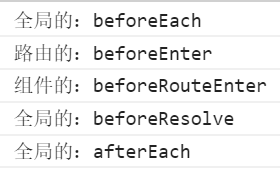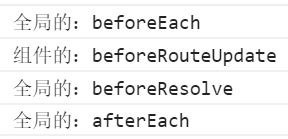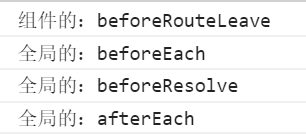导航守卫分类
导航守卫按照维度分三个:
全局的:进入任何一个路由都会执行
- beforeEach:进入路由前执行
- beforeResolve:在导航被确认之前,同时在所有组件内守卫和异步路由组件被解析之后,解析守卫就被调用
- afterEach:导航确认执行时执行,可理解为导航完成时执行
路由的:进入某个路由才会执行
- beforeEnter: 进入该路由前
组件的:进入某个组件才会执行组件复用时
- beforeRouteEnter: 进入组件时
- beforeRouteUpdate: 组件被复用时调用
- beforeRouteLeave: 离开组件前
例子
这么多的函数,执行先后顺序是什么呢,如何使用?请看下面的例子:
<!DOCTYPE html>
<html lang="en">
<head>
<meta charset="UTF-8">
<title>vue-router</title>
<script src="vue.js"></script>
<script src="vue-router.js"></script>
</head>
<body>
<div id="app">
<router-view></router-view>
</div>
<script>
const bar = {
template: '<div>bar-{{userId}}</div>',
computed: {
userId() { return this.$route.params.userId }
},
beforeRouteEnter (to, from, next) {
// 在渲染该组件的对应路由被 confirm 前调用
// 不!能!获取组件实例 `this`
// 因为当守卫执行前,组件实例还没被创建
console.log('beforeRouteEnter')
next()
},
beforeRouteUpdate (to, from, next) {
// 在当前路由改变,但是该组件被复用时调用
// 举例来说,对于一个带有动态参数的路径 /foo/:id,在 /foo/1 和 /foo/2 之间跳转的时候,
// 由于会渲染同样的 Foo 组件,因此组件实例会被复用。而这个钩子就会在这个情况下被调用。
// 如果不加这个钩子,则路由变化时页面检测不到数据变化
// 可以访问组件实例 `this`
console.log('beforeRouteUpdate')
next()
},
beforeRouteLeave (to, from, next) {
// 导航离开该组件的对应路由时调用
// 可以访问组件实例 `this`
console.log('beforeRouteLeave')
next()
}
}
const error = { template: '<div>oops! error</div>'}
const home = { template: '<div>this is home</div>'}
const routes = [
{ path: '/error', component: error },
{ path: '/', component: home },
// 路由独享守卫,用法与beforeEach一样
{ path: '/bar/:userId', component: bar, beforeEnter: ((to, from, next) => {
console.log('beforeEnter')
next()
})
}
]
const router = new VueRouter({
routes
})
// 全局前置守卫: 进入to路由前执行
router.beforeEach((to, from, next) => {
console.log('beforeEach')
console.log(to)
console.log(from)
// 正常跳转到下一个页面,
next()
// 跳转到指定页面
// 不能直接next('/error'),会陷入死循环 参考https://segmentfault.com/q/1010000012316727q/1010000012316727
// to.path == '/error' ? next() : next('/error')
// 只能停留在当前页面
// next(false)
})
// 全局解析守卫: 在导航被确认之前,同时在所有组件内守卫和异步路由组件被解析之后,解析守卫就被调用
router.beforeResolve((to, from, next) => {
console.log('beforeResolve')
// console.log(to)
// console.log(from)
next()
})
// 全局后置钩子: 导航被确认执行,可以理解为导航完成时执行
router.afterEach((to, from) => {
console.log('afterEach')
// console.log(to)
// console.log(from)
})
const app = new Vue({
el: "#app",
router
})
</script>
</body>
</html>导航守卫的解析流程
在上面的代码中加入了所有的守卫导航函数,下面来看看几种情况导航守卫的解析流程:
首先进入 '/bar/123' 即进入一个组件可以看到,控制台打印为:

然后我们将路径更改为:'/bar/234‘,复用组件
 '
'
最后更改为 ’/home' ,离开组件

从上面可以很好地理解导航的解析流程。
一些小坑
- next()
对于有next()的钩子函数
// 正常跳转到下一个页面,
next()
// 跳转到指定页面
// 不能直接next('/error'),会陷入死循环 参考https://segmentfault.com/q/1010000012316727q/1010000012316727
to.path == '/error' ? next() : next('/error')
// 只能停留在当前页面
next(false)
- beforeRouteUpdate
如果不加这个钩子,则路由变化时,页面检测不到数据变化:
beforeRouteUpdate (to, from, next) {
next()
}
